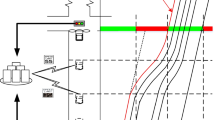Abstract
In general, dynamic traffic signal control or smooth driving benefits energy saving and CO2 emissions. However, most of studies in the past lack the integrated optimization of traffic signals control and instantaneous vehicle motion states simultaneously on energy saving and CO2 emission reduction. In this paper, a bi-level optimization model is proposed to minimize fuel consumption and CO2 emissions by considering real-time traffic signal control in road side unit (RSU) and instantaneous vehicle motion states optimization in on-board unit (OBU) synthetically. The RSU communicates with OBUs by vehicle wireless communication networks. Then, the traffic signal scheme in RSU is optimized with the received vehicle motion data sent from OBUs, and the system in vehicles optimize their speed and acceleration with the received traffic signal scheme sent from RSU. The simulation results indicate that the proposed model outperforms the existing Maximize Throughput Model (MaxTM) up to 10% in reducing fuel consumption and CO2 emissions especially when the traffic is heavy.














Similar content being viewed by others
References
IEA (2014) CO2 emissions from fuel combustion highlights 2014. p 136
IEA (2009) Transport, energy and CO2: Moving towards sustainability
Jacobsen MR (2012) Fuel economy and safety: The influences of vehicle class and driver behavior. Report, National Bureau of Economic Research
Sivak M, Schoettle B (2011) Eco-driving: strategic, tactical, and operational decisions of the driver that improve vehicle fuel economy
Symmons MA, Rose G (2009) Ecodrive training delivers substantial fuel savings for heavy vehicle drivers. In Proc. 5th international driving symposium on human factors in driver assessment
Lee W-H, Lai Y-C, Chen P-Y (2015) A study on energy saving and CO2 emissions reduction on signal countdown extension by vehicular ad-hoc network. IEEE Trans Veh Technol 64(3):890–900
Ahn K, Rakha H, Trani A, Van Aerde M (2002) Estimating vehicle fuel consumption and emissions based on instantaneous speed and acceleration levels. J Transp Eng 128(2):182–190
Li C, Shimamoto S (2012) An open traffic light control model for reducing vehicles’ emissions based on ETC vehicles. IEEE Trans Veh Technol 61(1):97–110
Alessandrini A, Cattivera A, Filippi F, Ortenzi F (2012) Driving style influence on car CO2 emissions. In 2012 international emission inventory conference
Xiang J, Chen Z (2016) An adaptive traffic signal coordination optimization method based on vehicle-to-infrastructure communication. Clust Comput 19(3):1–12
Adacher L (2012) A global optimization approach to solve the traffic signal synchronization problem. Procedia Soc Behav Sci 54(2290):1270–1277
Younes MB, Boukerche A (2016) Intelligent traffic light controlling algorithms using vehicular networks. IEEE Trans Veh Technol 65(8):5887–5899
Cipriani E, Fusco G (2004) Combined signal setting design and traffic assignment problem. Eur J Oper Res 155(3):569–583
Adacher L, Cipriani E (2010) A surrogate approach for the global optimization of signal settings and traffic assignment problem. In Proc. 2010 13th international IEEE conference on intelligent transportation systems (ITSC), pp. 60–65, IEEE
Farahani RZ, Miandoabchi E, Szeto W, Rashidi H (2013) A review of urban transportation network design problems. Eur J Oper Res 229(2):281–302
Alsabaan M, Alasmary W, Albasir A, Naik K (2013) Vehicular networks for a greener environment: a survey. IEEE Commun Surv Tutorials 15(3):1372–1388
NEDO (2009) Development of energy-saving ITS technologies. p 10
Alsabaan M, Naik K, Khalifa T, Nayak A (2012) Applying vehicular networks for reduced vehicle fuel consumption and CO2 emissions. Book chapter in intelligent transportation systems
Shiraishi T, Hanabusa H, Kuwahara M, Chung E, Tanaka S, Ueno H, Ohba Y, Furukawa M, Honda K, Maruoka K (2004) Development of a microscopic traffic simulation model for interactive traffic environment. In Proc. 11th ITSWC, Nagoya, Japan
Barcel J, Codina E, Casas J, Ferrer J, Garcia D (2005) Microscopic traffic simulation: a tool for the design, analysis and evaluation of intelligent transport systems. J Intell Robot Syst 41(2–3):173–203
Gao Z, Wu J, Sun H (2005) Solution algorithm for the bi-level discrete network design problem. Transp Res B Methodol 39(6):479–495
Sun H, Gao Z, Wu J (2008) A bi-level programming model and solution algorithm for the location of logistics distribution centers. Appl Math Model 32(4):610–616
Maher MJ, Zhang X, Van Vliet D (2001) A bi-level programming approach for trip matrix estimation and traffic control problems with stochastic user equilibrium link flows. Transp Res B Methodol 35(1):23–40
Bazaraa MS, Sherali HD, Shetty CM (2013) Nonlinear programming: theory and algorithms. Wiley, Hoboken
Dempe S (2005) Bilevel programming. In: Audet C, Hansen P, Savard G (eds) Essays and Surveys in Global Optimization. Springer, Boston, MA
Renders J-M, Flasse SP (1996) Hybrid methods using genetic algorithms for global optimization. IEEE Trans Syst Man Cybern B Cybern 26(2):243–258
Cernuschi S, Giugliano M, Cemin A, Giovannini I (1995) Modal analysis of vehicle emission factors Facteurs d’mission modaux des vhicules. Sci Total Environ 169(1):175–183
Nie YM, Li Q (2013) An eco-routing model considering microscopic vehicle operating conditions. Transp Res B Methodol 55:154–170
Alsabaan M, Naik K, Nayak A (2010) Applying vehicular ad hoc networks for reduced vehicle fuel consumption. Springer, New York, pp 217–228
Barth M, An F, Younglove T, Scora G, Levine C, Ross M, Wenzel T (2000) Comprehensive modal emission model (CMEM), version 2.0 users guide. University of California, Riverside
Rakha H, Ahn K, Trani A (2003) Comparison of MOBILE5a, MOBILE6, VT-MICRO, and CMEM models for estimating hot-stabilized light-duty gasoline vehicle emissions. Can J Civ Eng 30(6):1010–1021
Gao Y, Checkel MD (2007) Experimental measurement of on-road CO2 emission and fuel consumption functions. Report, SAE Technical Paper
Chowdhury MA, Sadek AW (2003) Fundamentals of intelligent transportation systems planning. Artech House, Norwood
Rakha H, Ahn K, Trani A (2004) Development of vt-micro model for estimating hot stabilized light duty vehicle and truck emissions. Transp Res Part D: Transp Environ 9(1):49–74
Author information
Authors and Affiliations
Corresponding author
Rights and permissions
About this article
Cite this article
Liu, K., Li, J., Li, W. et al. Bi-Level Optimization Model for Greener Transportation by Vehicular Networks. Mobile Netw Appl (2018). https://doi.org/10.1007/s11036-018-1054-7
Published:
DOI: https://doi.org/10.1007/s11036-018-1054-7




